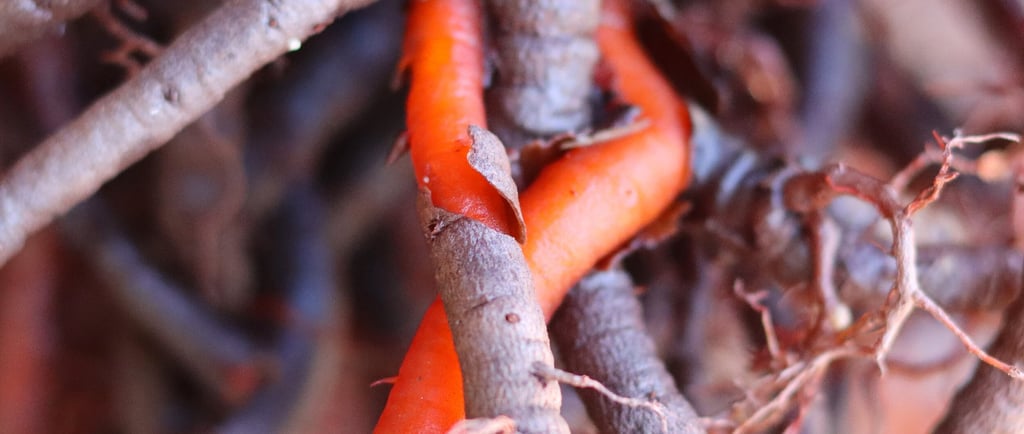❤️The Royal Red Hidden in the Root - Alizarin Crimson 👑
🌱 A follow-up story that connects Art, History and Biology. 🌿✨Beautifully growing from Chapter Colors in the Art Album this story invites children to explore how people not only admired and experimented with plants but found color hidden in their very roots—like the madder plant, whose crimson pigment sparked royal fashion and ancient rituals. 👑🧵 It links practical plant use to ancient textile culture, showing the invisible threads connecting botany, craftsmanship, and early human societies. This story also sets the stage for the rise of trade, discovery, and even scientific investigation. It invites children to ask: “What other colors are hidden in roots ?” and wonder “What stories do the colors we wear have?” 🌈💭
ART STORIES
8/28/20252 min read


Red is a color that grabs our attention—it’s bold, warm, and makes people notice! Think of stop signs, traffic lights, and even bright red berries in the forest. 🍓🚦🌺 Where else do you see red in nature? Flowers, feathers, sunsets—and leaves that turn reddish in autumn. 🍁 People have always noticed this powerful color and wished to wear it. So they went on a mission: to find the perfect red dye for their robes and their art.
Before people made paintings on canvas or paper, before they could even color fabrics, they had to learn something very important—how to make the fabric itself!
More than 3000 years ago, in ancient places like Egypt, Mesopotamia, the Indus Valley, and Persia, people discovered that plants and animals could give them fibers to weave. 🌾🐑
In Egypt, they took the long, silky threads from flax stems and spun them into linen. In the Indus Valley, people picked cotton and softened it into thread. In Persia, they combed the soft wool from sheep to make warm, thick cloth. These early weavers worked with care—stretching, twisting, and weaving strands into beautiful fabrics using looms made of wood and string.
The result? Cloth! But the colors were pale—beige, off-white, maybe gray. 🌱
And that’s when the next big question came… “Can we bring the colors of nature into the cloth we wear?” So they started experimenting.
They mashed petals, soaked leaves, crushed berries, and boiled bark. Some colors faded fast. Some didn’t stick. But… sometimes, something magical happened. They made a vibrant red, that stuck and lasted...
One of the oldest and most powerful reds came from a simple plant called madder. And not from the leaves, nor from the flowers, but from the roots—hidden underground! 🌿
When they crushed and boiled these roots, they created a red dye that glowed like sunlight at sunset. This special dye became known as Alizarin Crimson (👏 a-li-za-rin crim-son 👏), one of the most treasured shades of red in history. The name comes from the Arabic word al-zarīn, meaning “pressed juice,” and may also be linked to kermes, an ancient word for red dye from insects. Together, it means “red dye juice.”
The pigment was very expensive.👑 In Ancient Egypt, priests and royalty wore alzarin red robes to feel close to the gods.⚔️ In Persia, warriors dyed their tunics with madder before battle, believing it brought courage. 🎨 In the Indus Valley, madder red was used in sacred rituals, painted on pottery and statues as a sign of life and power.
🌍 The red of madder spread across the world and across the centuries. Even though people later invented many red shades , Alizarin Crimson stayed. Many textile artists still use madder root the traditional way—just like the ancient weavers did. 🎨🧵
And here’s something fun: Scientists once fed madder to animals—and guess what happened? Their bones turned red! 🦴🌿 This surprising discovery helped biologists learn how bones grow and how pigments travel through the body. Isn’t that wild?
Alizarin Crimson was once a royal trend—a color worn to show importance and beauty. But across the sea… a different mystery was rising. A new fashion was on the horizon.
Some called it the color of the gods. Others called it ‘the blood of the sea.’ This is a story for another day that begins with the sea and ends in the robes of emperors. 👑🌊🐌
💭 I Wonder… Where might madder still grow today? Could there be other roots that hide rich colors in the soil? What secrets are still buried beneath our feet?
With Montessori joy,
Vanina 😊

